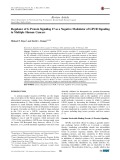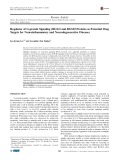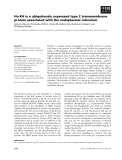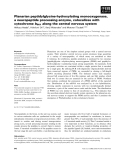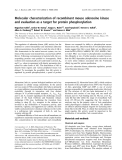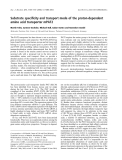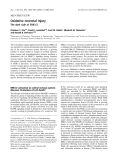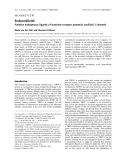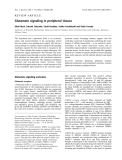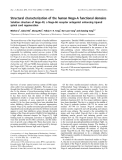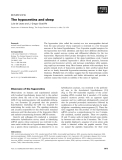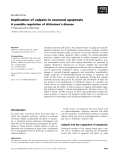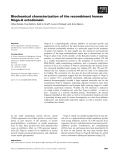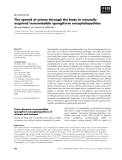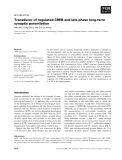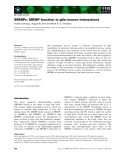
Central nervous system
-
Regulators of G protein signaling (RGS) proteins modulate G protein-coupled receptor (GPCR) signaling networks by terminating signals produced by active Gα subunits. RGS17, a member of the RZ subfamily of RGS proteins, is typically only expressed in appreciable amounts in the human central nervous system, but previous works have shown that RGS17 expression is selectively upregulated in a number of malignancies, including lung, breast, prostate, and hepatocellular carcinoma.
 10p
10p  caothientrangnguyen
caothientrangnguyen
 09-05-2020
09-05-2020
 13
13
 1
1
 Download
Download
-
Regulator of G-protein signaling (RGS) proteins were originally identified as negative regulators of G-protein-coupled receptor (GPCR) signaling via their GTPase-accelerating protein (GAP) activity. All RGS proteins contain evolutionarily conserved RGS domain; however, they differ in their size and regulatory domains. RGS1 and RGS10 are smaller than other RGS proteins, and their functions involve various inflammatory responses including autoimmune responses in both the periphery and the central nervous system (CNS). Neuroinflammation is the chronic inflammatory response in the CNS.
 5p
5p  caothientrangnguyen
caothientrangnguyen
 09-05-2020
09-05-2020
 28
28
 2
2
 Download
Download
-
Regulator of G protein signaling (RGS) proteins are gatekeepers regulating the cellular responses induced by G protein-coupled receptor (GPCR)-mediated activation of heterotrimeric G proteins. Specifically, RGS proteins determine the magnitude and duration of GPCR signaling by acting as a GTPase-activating protein for Gα subunits, an activity facilitated by their semiconserved RGS domain. The R7 subfamily of RGS proteins is distinguished by two unique domains, DEP/DHEX and GGL, which mediate membrane targeting and stability of these proteins.
 13p
13p  caothientrangnguyen
caothientrangnguyen
 09-05-2020
09-05-2020
 25
25
 1
1
 Download
Download
-
Theo nghĩa sinh học, mạng nơ-ron là một tập hợp các dây thần kinh kết nối với nhau. Ngày nay, thuật ngữ này còn dùng để chỉ mạng nơ-ron nhân tạo, cấu thành từ các nơ-ron nhân tạo. Do đó thuật ngữ 'mạng nơ-ron' xác định hai khái niệm phân biệt: Mạng nơ-ron sinh học là một mạng lưới (plexus) các nơ-ron có kết nối hoặc có liên quan về mặt chức năng trực thuộc hệ thần kinh ngoại biên (peripheral nervous system) hay hệ thần kinh trung ương (central nervous system). Trong ngành thần kinh học...
 13p
13p  and_12
and_12
 08-08-2013
08-08-2013
 86
86
 10
10
 Download
Download
-
Hu-K4 is a human protein homologous to the K4L protein of vaccinia virus. Due to the presence of two HKD motifs, Hu-K4 was assigned to the family of Phospholipase D proteins although so far no catalytic activity has been shown. The Hu-K4 mRNA is found in many human organs with highest expression levels in the central nervous system. We extended the ORF of Hu-K4 to the 5¢ direction. As a consequence the protein is 53 amino acids larger than originally predicted, now harbouring a putative transmembrane domain....
 0p
0p  awards
awards
 06-04-2013
06-04-2013
 39
39
 3
3
 Download
Download
-
Planarians are one of the simplest animal groups with a central nervous system. Their primitive central nervous system produces large quantities of a variety of neuropeptides, of which many are amidated at their C terminus. In vertebrates, peptide amidation is catalyzed by two enzymes [peptidylglycine a-hydroxylating monooxygenase (PHM) and peptidyl-a-hydroxylglycinea-amidating lyase] acting sequentially. In mammals, both enzymatic activities are contained within a single protein that is encoded by a single gene....
 14p
14p  awards
awards
 05-04-2013
05-04-2013
 42
42
 4
4
 Download
Download
-
Prion diseases are characterized by the accumulation of a pathogenic mis-folded form of a prion protein (PrP) encoded by the Prnpgene in humans. In the present study in zebrafish, two transcripts and the corresponding genes encoding prion proteins, PrP1 and PrP2, related to human PrP have been characterized with a relatively divergent deduced amino acid sequence, but a well preserved overall organization of structural prion pro-tein motifs.
 14p
14p  awards
awards
 05-04-2013
05-04-2013
 39
39
 2
2
 Download
Download
-
The regulation of adenosine kinase (AK) activity has the potential to control intracellular and interstitial adenosine (Ado) concentrations. In an effort to study the role of AK in Ado homeostasis in the central nervous system, two iso-forms of the enzymewere cloned fromamouse brain cDNA library. Following overexpression in bacterial cells, the cor-responding proteins were purified to homogeneity.
 9p
9p  awards
awards
 05-04-2013
05-04-2013
 37
37
 2
2
 Download
Download
-
The PAT2 transporter has been shown to act as an electro-genic proton/amino acid symporter. The PAT2 cDNA has been cloned fromvarious human, mouse and rat tissues and belongs to a group of four genes (pat1topat4)withPAT3 and PAT4 still resembling orphan transporters. The first immunolocalization studies demonstrated that the PAT2 protein is found in the murine central nervous system in neuronal cells with a proposed role in the intra and/or intercellular amino acid transport.
 8p
8p  awards
awards
 05-04-2013
05-04-2013
 53
53
 5
5
 Download
Download
-
The extracellular signal regulated protein kinases (ERK1/2) are essential for normal development and functional plasti-city of the central nervous system. However, a growing number of recent studies in models of cerebral ischemia, brain trauma and neurodegenerative diseases implicate a detrimental role for ERK1/2 signaling during oxidative neuronal injury. Neurons undergoing oxidative stress-rela-ted injuries typically display a biphasic or sustained pattern of ERK1/2 activation.
 7p
7p  dell39
dell39
 03-04-2013
03-04-2013
 40
40
 3
3
 Download
Download
-
Endovanilloids are defined as endogenous ligands of the transient receptor potential vanilloid type 1 (TRPV1) protein,a nonselective cation channel that belongs to the large family of TRP ion channels,and is activated by the pungent ingredient of hot chilli peppers,capsaicin. TRPV1 is expressed in some nociceptor efferent neurons, where it acts as a molecular sensor of noxious heat and low pH. However,the presence of these channels in var-ious regions of the central nervous system,where they are not likely to be targeted by these noxious stimuli,suggests the existence of endovanilloids.
 8p
8p  dell39
dell39
 03-04-2013
03-04-2013
 43
43
 2
2
 Download
Download
-
The hypothesis thatL-glutamate (Glu) is an excitatory amino acid neurotransmitter in the mammalian central nervous system is now gaining more support after the suc-cessful cloning of a number of genes coding for the signaling machinery required for this neurocrine at synapses in the brain. These include Glu receptors (signal detection), Glu transporters (signal termination) and vesicular Glu trans-porters (signal output through exocytotic release).
 13p
13p  dell39
dell39
 03-04-2013
03-04-2013
 64
64
 4
4
 Download
Download
-
The recent discovery of theNogo family ofmyelin inhibitors and theNogo-66 receptor opens upa very promising avenue for the development of therapeutic agents for treating spinal cord injury. Nogo-A, the largest member of the Nogo fam-ily, is a multidomain protein containing at least two regions responsible for inhibiting central nervous system (CNS) regeneration. So far, no structural information is available for Nogo-A or any of its structural domains. We have sub-cloned and expressed two Nogo-A fragments, namely the 182 residueNogo-A(567–748) and the 66 residueNogo-66 in Escherichia coli..
 11p
11p  dell39
dell39
 03-04-2013
03-04-2013
 48
48
 4
4
 Download
Download
-
The hypocretins (also called the orexins) are two neuropeptides derived from the same precursor whose expression is restricted to a few thousand neurons of the lateral hypothalamus. Two G-protein coupled receptors for the hypocretins have been identified, and these show different distributions within the central nervous system and differential affinities for the two hypocretins.
 14p
14p  dell39
dell39
 27-03-2013
27-03-2013
 24
24
 3
3
 Download
Download
-
Apoptotic neuronal cell death is the cardinal feature of aging and neurode-generative diseases, but its mechanisms remain obscure. Caspases, members of the cysteine protease family, are known to be critical effectors in central nervous system cellular apoptosis. More recently, the calcium-dependent proteases, calpains, have been implicated in cellular apoptotic processes. Indeed, several members of the Bcl-2 family of cell death regulators, nuc-lear transcription factors (p53) and caspases themselves are processed by calpains. ...
 7p
7p  inspiron33
inspiron33
 25-03-2013
25-03-2013
 40
40
 6
6
 Download
Download
-
Nogo-A is a physiologically relevant inhibitor of neuronal growth and regeneration in the myelin of the adult human central nervous system and has attracted considerable attention as a molecular target for the treatment of spinal cord injuries.
 11p
11p  galaxyss3
galaxyss3
 21-03-2013
21-03-2013
 49
49
 3
3
 Download
Download
-
Transmissible spongiform encephalopathies are fatal neurodegenerative dis-eases that are caused by unconventional pathogens and affect the central nervous system of animals and humans. Several different forms of these dis-eases result from natural infection (i.e. exposure to transmissible spongiform encephalopathy agents or prions, present in the natural environment of the respective host).
 18p
18p  galaxyss3
galaxyss3
 21-03-2013
21-03-2013
 37
37
 2
2
 Download
Download
-
In the central nervous system, long-term adaptive responses to changes in the environment, such as the processes involved in learning and memory, require the conversion of extracellular stimuli into intracellular signals. Many of these signals involve the induction of gene expression.
 6p
6p  galaxyss3
galaxyss3
 19-03-2013
19-03-2013
 38
38
 4
4
 Download
Download
-
Amyloid-b(Ab) aggregation and amyloid formation are key pathological features of Alzheimer’s disease, and are considered to be two of the major contributing factors to neurodegeneration and dementia. Identification of small molecule inhibitors that are orally available, have low toxicity and high central nervous system bioavailability is one approach to the potential development of a disease-modifying treatment for Alzheimer’s disease.
 12p
12p  media19
media19
 06-03-2013
06-03-2013
 48
48
 2
2
 Download
Download
-
The mammalian nervous system is relatively autonomous in lipid metabolism. In particular, Schwann cells in the peripheral nervous system, and oligodendrocytes and astrocytes in the central nervous system, are highly active in lipid synthesis.
 9p
9p  vinaphone15
vinaphone15
 27-02-2013
27-02-2013
 45
45
 3
3
 Download
Download
CHỦ ĐỀ BẠN MUỐN TÌM








